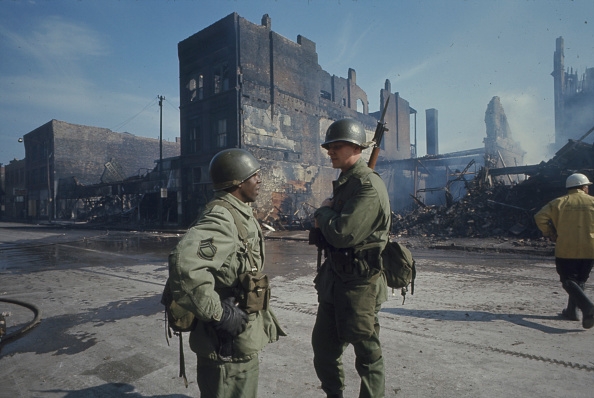You have /5 articles left.
Sign up for a free account or log in.

National Guardsmen after Chicago riots, April 1968
Getty Images
The wave of tragic and troubling events of recent days in our country -- such as the shooting of black Americans in Baltimore, Baton Rouge and St. Paul, the attacks against police in Dallas and Birmingham, and terrorist rampages in Orlando and San Bernardino -- has brought me back to another tumultuous time: the spring and summer of 1968.
I remember it well because I was a college senior about to graduate. I remember the night of April 5, when I had planned to go into Chicago for an event. Martin Luther King Jr. had been assassinated the day before in Memphis, and that night, Chicago seethed and exploded: a 28-block stretch of Madison Street was left largely in ruins; 36 major fires were reported; 11 people were killed; 48 were wounded by police gunfire and 90 policemen were injured. In two days 2,150 people were arrested. Thousands of army troops were sent in to restore order.
The summer before, I had worked with teenagers in the Cabrini-Green Homes on Chicago’s Near North Side. I lived in a largely African-American church community. I felt comfortable joining pickup games on the asphalt basketball courts and visiting families in these high-rise apartments. After the spring of 1968, gunfire became commonplace from the upper floors of Cabrini-Green, and deep racial tensions made my normal kind of coming and going impossible.
On the Wednesday before graduation, June 5, 1968, I awoke to learn that Bobby Kennedy had just been shot in Los Angeles after winning the California Democratic primary. I can remember a deep sense that our nation seemed to be splitting apart -- a fear that seemed to be coming true when the Democratic National Convention met later that summer in Chicago and spiraled into chaos. Ten thousand demonstrators gathered outside and were met by 23,000 police and National Guard members. These violent clashes were broadcast live to the nation.
The current moment in America reminds me of 1968: the heightened racial tension, repeated incidents of violence, denunciations and defense of police -- all against the backdrop of an overheated political season. Then, many young people felt alienated from the system and found little hope in either candidate of the major parties.
In such troubled times, what are we to think? How are we to act? I have no grand answers to our deep problems as a nation and as a society. The fact is there are no easy answers. But what can we do as college and university leaders? What can our campus communities do? What can I do? What follows is what I am committing myself to, as best I can.
Acknowledge hard truths. The dilemmas of race continue to plague our society. Many of our students will return to campus feeling the pain of racial disparity and racial conflict, which are serious problems that we must not ignore.
Last fall, students across the country were hurt, angry and frustrated by a series of racially charged events and the unnecessary deaths of several unarmed black citizens. Some arrived at their campuses with lists of demands seeking social justice and equity. After another tenuous summer, we must again acknowledge their pain and outrage in the hopes that a modern university setting can help shape national discourse instead of simply being a backdrop for unrest and confusion. We must rededicate ourselves to the unfinished work before us: shaping a society in which everyone, created as equals, receives treatment as such.
Listen and learn. Increasingly in America today, we live in neighborhoods of the like-minded and gain information from like-minded sources. Even on a university campus, it takes effort to cross cultural and racial boundaries. I am convinced that party lines and pat answers are not sufficient to address such troublesome times. We must listen to voices other than accustomed ones. We must be open to adjusting our thinking and our behavior. We must push ourselves beyond what is comfortable, broadening our network of friends and deepening our capacity for empathy. How long has it been since we have, even imaginatively, seen the world through the eyes of someone very different than ourselves?
Like many institutions, Wake Forest University has its most diverse student body ever and is among the 10 fastest changing universities in the country, according to The New York Times. We refer to ourselves as a community in progress, which reflects our belief that we must actively practice what it means to be in community together and that regular updates must hold us accountable to each other. Our strength as a campus community -- and as a nation -- rests on our ability to listen to the voices of others and learn from experiences different from our own.
Start a conversation. Do the hard work of dialogue with those with whom we disagree. We all need occasions to frame challenging conversations and methods to facilitate those discussions. A college campus must foster honest, face-to-face conversation, however difficult, in the classroom, in residence halls and on structured and unstructured occasions. Doing the hard work of dialogue with those with whom we disagree is a common topic among college presidents today.
A recent article in Inside Higher Ed included a charge given by my friend and colleague Harry Pastides, president of the University of South Carolina, in which he urged students and faculty members to “recommit to airing our views in a way that is civil and responsible and recommit to opposing violence in all of its of forms,” including violent language and hate speech. “Come back to campus ready to learn and prepared for conversations to come,” the president wrote. “Most importantly, be ready to extend the hand of friendship to a new face.”
Conversation matters. And it must begin with us.
Retain hope. The United States has a wonderful -- and deeply flawed -- history. As the historian Edmund Morgan has emphasized, we are a nation founded both in liberty and in slavery. This land has provided much opportunity and social mobility for immigrants, and it has made progress since the 1960s in establishing broad gains for African-Americans in education, in business and the professions, and in civic life.
Yet whatever progress has been made in race relations and attitudes, racism is still a troubling reality, and patterns of poverty, particularly in urban communities, seem to extend from generation to generation. Today, we must redouble our efforts in the noble quest for which so many have given their lives: to build a society where life, liberty and the pursuit of happiness remain within the grasp of everyone.
In 1963, Martin Luther King Jr. implored those who would listen. “Darkness cannot drive out darkness: only light can do that,” he said. “Hate cannot drive out hate: only love can do that.” As we -- on our campuses and in America in general -- walk through what feels like another dark hour, let us be people who carry the light and let us be people who choose to love.








